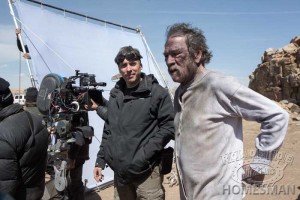
Set against the sparse, austere backdrop of 1850s Nebraska, The Homesman tells the story of strong-willed homesteader Mary Bee Cuddy (Hillary Swank) and George Briggs, the low-life-schemer (Tommy Lee Jones) who she employs to help her transport back to “civilization” three women driven insane by the harsh realities of life on the frontier, a reality that can even make a strong woman crack.
The story was taken from a Glendon Swarthout book and brought to Jones by his producer, Michael Fitzgerald (The Three Burials of Melquiades Estrada) who wanted to see if it would make a good movie. Jones thought they could write a screenplay with some originality in it. “And of course our lives are a constant quest for originality,” stated Jones.
It was early fall and the goal was to be shooting by spring. To accelerate the writing process, Jones worked with writers Wesley Oliver and Kieran Fitzgerald. Interested in exploring the female condition, Jones decided to delve more deeply into the histories of the deranged women than had been done in the novel. “I wanted three notebooks full of vignettes – anywhere from a quarter to a half page long – small scenes that might describe an incident in any one of these women’s journey into madness,” shared Jones.
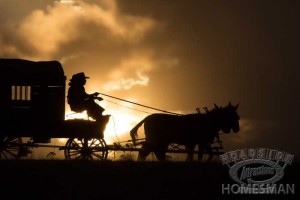
The writers tried to take a woman’s point of view for the story. Much of the cinematic vocabulary of the film came from the images of women on the frontier that helped inspire the screenwriting as well as other crafts.
Fitzgerald, the youngest writer, put together 15 vignettes for the youngest girl, Oliver was assigned the middle woman and Jones took the oldest one. “I’ll write the screenplay, and we’ll use these three notebooks… we’ll have a vault of flashbacks, that we can put in any time we want to,” explained Jones. “The camera will be athletic. I’ll be able to put it in a place that will motivate a memory that we’ll shoot.” The placement of those “memory bits” was decided not only while shooting, but also during the editing.
Writing, producing, directing and acting in the film, Jones was deeply immersed in all aspects of the film. He based his minimalist vision for the story on a desire for historical accuracy and a strong attention to minute details. His lens focused on the struggles of these finely drawn characters. Photographs depicting the houses and people of the period inspired many of the design elements for the film, providing a rich mine of architectural and costume designs as well as a references for hair and makeup.
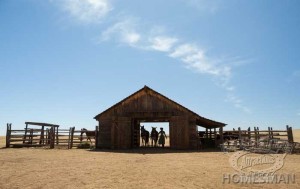 “We were very lucky to find that there was an itinerate photographer working in Nebraska in the middle of the 19th century – the very time when our movie was set. His name was Soloman Butcher. He made his living taking pictures of people in front of sod houses. He would use a wide lens, which would take in the entire house,” revealed Jones. “Of course, having a family photograph was something very rare and special. These people would come with everything they had. They would put on their best clothes, get all the children, get grandpa, get everybody out there. If they had a good year with watermelons, for example, they would bring out a table and cut a watermelon in half, face it towards the lens. If they had an animal, a milk cow they were proud of, they would make sure she was in the shot. There was one picture Butcher took of some people who lived in a dugout. They couldn’t get their beautiful milk cow in the shot, so they put it up on the roof, which wasn’t really a roof because one fourth of the house is a hole in the ground.”
“We were very lucky to find that there was an itinerate photographer working in Nebraska in the middle of the 19th century – the very time when our movie was set. His name was Soloman Butcher. He made his living taking pictures of people in front of sod houses. He would use a wide lens, which would take in the entire house,” revealed Jones. “Of course, having a family photograph was something very rare and special. These people would come with everything they had. They would put on their best clothes, get all the children, get grandpa, get everybody out there. If they had a good year with watermelons, for example, they would bring out a table and cut a watermelon in half, face it towards the lens. If they had an animal, a milk cow they were proud of, they would make sure she was in the shot. There was one picture Butcher took of some people who lived in a dugout. They couldn’t get their beautiful milk cow in the shot, so they put it up on the roof, which wasn’t really a roof because one fourth of the house is a hole in the ground.”
A personal family friend, in addition to an accomplished production designer, Merideth Bosworth (Apollo 13), has worked with Jones on seven films and understands his sensibilities, so she was up to the task of creating the sets for the film. “She’s very bright. She’s very funny and we have a lot of fun. It is easy to exchange ideas. We work easily and well together. A lot of time there is interdepartmental conflict, as you know very well. She knows I’ll protect her, until we run out of money,” said Jones.
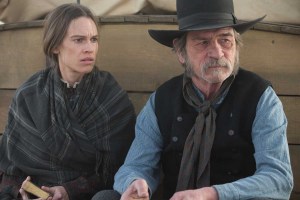 The open vistas of northeastern New Mexico stood in for the plains of Nebraska. The landscapes played an important character in the emotional intent of the film. To recreate the unique settings in the territories, sets were built or re-built for the film. The town of Loop was partially built by the filmmakers. “It’s an old, worn-out western movie set. I’ve worked on it two or three times over the last 30 years,” said Jones. “You can change it easily and we did change it. We put some new structures in, altered some of the old ones and we took advantage of computers to finish off the town.”
The open vistas of northeastern New Mexico stood in for the plains of Nebraska. The landscapes played an important character in the emotional intent of the film. To recreate the unique settings in the territories, sets were built or re-built for the film. The town of Loop was partially built by the filmmakers. “It’s an old, worn-out western movie set. I’ve worked on it two or three times over the last 30 years,” said Jones. “You can change it easily and we did change it. We put some new structures in, altered some of the old ones and we took advantage of computers to finish off the town.”
The team used subtle changes in the landscape to coincide with the characters personal journeys over the course of the five-week trek from the barren plains across craggy hills through woodlands to the cultured Iowa town at the end of the film. That location was actually historic Westville, Georgia made up of authentic building from the 1850s that had been transported and reassembled at a site near Lumpkin, Georgia.
One of Jones’ first-time collaborators on the movie was veteran costume designer, Lahly Poore (Titanic). She had an extensive knowledge of the time period, but her emphasis on character as a way to inform the costumes won her the job.“Lahly’s very well-informed about the way people dressed in that time in the West,” said Jones. “She was very thorough in her research as to what the Pawnee people looked like. I never had to worry about her historical accuracy.”
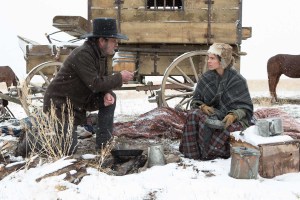 Poore took her design cues not only from the vintage photos, but also from a social movement where women started wearing pants under their thigh length dresses. “There was a women’s movement going on and that was kind of a signature way of dressing. They weren’t suffragettes. This was a little before that, but they were women looking for independence, not brave enough yet to be clamoring for the vote,” Jones explained.
Poore took her design cues not only from the vintage photos, but also from a social movement where women started wearing pants under their thigh length dresses. “There was a women’s movement going on and that was kind of a signature way of dressing. They weren’t suffragettes. This was a little before that, but they were women looking for independence, not brave enough yet to be clamoring for the vote,” Jones explained.
The majority of the story takes place in the wide-open spaces of the plains topped by an endless sky. In addition to recognizing the cinematographer’s talent, Jones was drawn into his first collaboration with Rodrigo Prieto because, “He knows how to shoot big, wide exteriors in the west. That’s the foundation of the photography of this movie. If you get to know him, he is very personable guy, likeable, well-organized and very intelligent.”
Although the filmmakers had debated shooting in black and white, color was important for conveying the subtleties of the austerely beautiful landscapes. To achieve the look of a classic Western, daytime scenes were shot on 35 mm film with its grainy texture, but for low-light night shots, the Sony F55 was used and film grain was added in post.
Jones is very comfortable working with editor Roberto Silvi (Tombstone) who cut both The Three Burials of Melquiades Estrada and The Sunset Limited for the director. The editor was on location in New Mexico organizing and assembling the footage. Jones explained, “Based on the way we shoot, most of the editorial decisions are obvious and self-evident,” He continued talking about how to work with an editor, saying, “One time, years ago, I asked my friend Ron Shelton what would be the best point of view to take with an editor. He said, ‘Over their shoulder.’”
The score evokes the loneliness and desolation of the homesteaders’ daily lives, using themes that had the flavor of mid-19th century folk songs, with a twist. In pursuit of originality, composer Marco Beltrami (The Hurt Locker) and his associate Buck Sanders created instruments and experimented with recording techniques, such enlisting the wind as a key player in the making of the music through the use of their “wind piano.” Jones, who has worked with Beltrami twice before, likes the composer because “he’s different, and original.”
In this original look at the hardships the women of the frontier endured, Jones and his crew have created an emotional and authentic environment for the characters within the story to play out their journeys.





